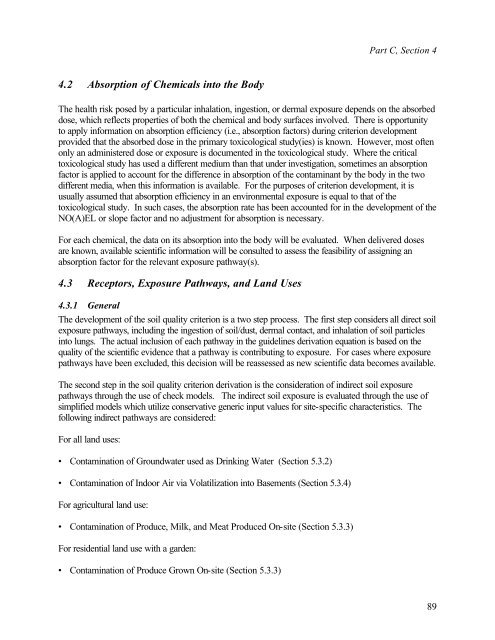Protocol for the Derivation of Environmental and Human ... - CCME
Protocol for the Derivation of Environmental and Human ... - CCME
Protocol for the Derivation of Environmental and Human ... - CCME
Create successful ePaper yourself
Turn your PDF publications into a flip-book with our unique Google optimized e-Paper software.
Part C, Section 4<br />
4.2 Absorption <strong>of</strong> Chemicals into <strong>the</strong> Body<br />
The health risk posed by a particular inhalation, ingestion, or dermal exposure depends on <strong>the</strong> absorbed<br />
dose, which reflects properties <strong>of</strong> both <strong>the</strong> chemical <strong>and</strong> body surfaces involved. There is opportunity<br />
to apply in<strong>for</strong>mation on absorption efficiency (i.e., absorption factors) during criterion development<br />
provided that <strong>the</strong> absorbed dose in <strong>the</strong> primary toxicological study(ies) is known. However, most <strong>of</strong>ten<br />
only an administered dose or exposure is documented in <strong>the</strong> toxicological study. Where <strong>the</strong> critical<br />
toxicological study has used a different medium than that under investigation, sometimes an absorption<br />
factor is applied to account <strong>for</strong> <strong>the</strong> difference in absorption <strong>of</strong> <strong>the</strong> contaminant by <strong>the</strong> body in <strong>the</strong> two<br />
different media, when this in<strong>for</strong>mation is available. For <strong>the</strong> purposes <strong>of</strong> criterion development, it is<br />
usually assumed that absorption efficiency in an environmental exposure is equal to that <strong>of</strong> <strong>the</strong><br />
toxicological study. In such cases, <strong>the</strong> absorption rate has been accounted <strong>for</strong> in <strong>the</strong> development <strong>of</strong> <strong>the</strong><br />
NO(A)EL or slope factor <strong>and</strong> no adjustment <strong>for</strong> absorption is necessary.<br />
For each chemical, <strong>the</strong> data on its absorption into <strong>the</strong> body will be evaluated. When delivered doses<br />
are known, available scientific in<strong>for</strong>mation will be consulted to assess <strong>the</strong> feasibility <strong>of</strong> assigning an<br />
absorption factor <strong>for</strong> <strong>the</strong> relevant exposure pathway(s).<br />
4.3 Receptors, Exposure Pathways, <strong>and</strong> L<strong>and</strong> Uses<br />
4.3.1 General<br />
The development <strong>of</strong> <strong>the</strong> soil quality criterion is a two step process. The first step considers all direct soil<br />
exposure pathways, including <strong>the</strong> ingestion <strong>of</strong> soil/dust, dermal contact, <strong>and</strong> inhalation <strong>of</strong> soil particles<br />
into lungs. The actual inclusion <strong>of</strong> each pathway in <strong>the</strong> guidelines derivation equation is based on <strong>the</strong><br />
quality <strong>of</strong> <strong>the</strong> scientific evidence that a pathway is contributing to exposure. For cases where exposure<br />
pathways have been excluded, this decision will be reassessed as new scientific data becomes available.<br />
The second step in <strong>the</strong> soil quality criterion derivation is <strong>the</strong> consideration <strong>of</strong> indirect soil exposure<br />
pathways through <strong>the</strong> use <strong>of</strong> check models. The indirect soil exposure is evaluated through <strong>the</strong> use <strong>of</strong><br />
simplified models which utilize conservative generic input values <strong>for</strong> site-specific characteristics. The<br />
following indirect pathways are considered:<br />
For all l<strong>and</strong> uses:<br />
• Contamination <strong>of</strong> Groundwater used as Drinking Water (Section 5.3.2)<br />
• Contamination <strong>of</strong> Indoor Air via Volatilization into Basements (Section 5.3.4)<br />
For agricultural l<strong>and</strong> use:<br />
• Contamination <strong>of</strong> Produce, Milk, <strong>and</strong> Meat Produced On-site (Section 5.3.3)<br />
For residential l<strong>and</strong> use with a garden:<br />
• Contamination <strong>of</strong> Produce Grown On-site (Section 5.3.3)<br />
89
















